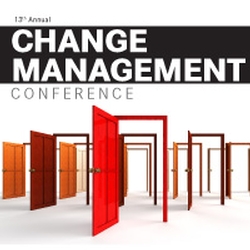 Recently I had the opportunity to attend the 13th Annual Change Management Conference in New York, NY, hosted by The Conference Board. The event represented a convening of 200+ change management professionals from around the United States.
Recently I had the opportunity to attend the 13th Annual Change Management Conference in New York, NY, hosted by The Conference Board. The event represented a convening of 200+ change management professionals from around the United States.
200+ attendees is a pretty decent size, but this larger number of attendees is quite small when you consider the number of people serving in official or unofficial change management roles around the world (either as employees or consultants), or when compared to the number of project managers (estimated at 16.5 million people around the world) and potentially as many as 1.5 million six sigma black belts and green belts sprinkled around the world.
Meanwhile, a couple of the leading training organizations in the change management space have trained just short of 100,000 people in the principles of change management.
If you agree that proactively managing change in organizations is at least as important as the practice of Six Sigma, and potentially as important as project management, that means that as the pace and importance of change continues to gather steam, there could be the need to train between 1.4 million and 16.4 million change management professionals in the next few years.
Insights from The Conference Board’s Council on Change Management
The tweet stream kicked off with a tweet from Joe Rafter of PG&E (@jrafter65) capturing the essence of what was to come:
“Investing in better change & transformation today. Change is in everyone’s role.”
The first session highlighted the Council’s Five Guiding Principles for Changing How We Change:
- Agile, Conitnuous and Iterative
- Future Focused
- Dynamic Conversation & Engagement
- Change Leadership From All Levels
- Adoption & Behavior Change
Kinthi Sturtevant of IBM highlighted that they are rarely seeing 2, 3 or 4 year projects. Now it’s 30-60-90 day change projects.
We heard John Horn of Prudential talking about their transformation to a focus on talent as a differentiator that is not hr led, but leader led. Interesting that Prudential has talent catalysts in the same way as Intuit has design catalysts.
We heard Barbara Mitchell of Mayo Clinic talking about the importance of embedding your change plan in your project plan. But I disagree with this strategy. The focus should be the reverse. Your project plan should be part of your change plan. In my estimation, project planning should be part of our change planning efforts, but to make this happen we need more change planning tools like my upcoming Change Planning Toolkit™.
Wendy Branche of Tyco spoke about how organizations must make change a capability not just a competency. Distributing and democratizing change must be a priority. At Tyco change is a business process and a leadership competency and positioning change in such a manner has accelerated participation in change.
People First in Change Management
Gisela Paulsen of Genentech spoke about leading people through a difficult transition, and her feelings were captured well in this quote:
“If you lead change with integrity and transparency you can’t go wrong.”
The company had to deal with a product that was dying in two years as a superior product came on the market from a competitor, and one of the ways they dealt with it was by allowing employees to start spending 40% of their time on career development activities.
She spoke about the importance of paying attention to the community and its well-being during the change process, and how leading on the way down is a lot harder and you learn more about leadership than learning during a growth phase.
One other key message from Gisela was that as a change leader, you must be courageous, and not be afraid to ask for things. Who knows? Leadership might say yes!
The Innovation Accelerator
Roberto Masiero and Dr. Eric Hieger of ADP spoke about their efforts to accelerate innovation, and it was funny that they intentionally dressed different to highlight the difference between the old ADP and the new ADP. There
One key question they asked was:
Do we intentionally accelerate pace amplitude scale and complexity in a VUCA environment?
(VUCA being Volatile, Uncertain, Complex, and Ambiguous)
How Do You Measure Change Success?
Tim Creasey of ProSci spoke a lot about the importance of metrics and scorecards. Here are a couple of the key takeaways:
Tim Creasey’s definition of Change Management is “catalyzing individual transitions to deliver organizational results.”
- Most of the people at the conference feel they do a poor job of measuring change management performance
- My big takeaway was that many times the ROI of change mgmt activities are likely baked into the overall ROI for systems projects especially, but the investment and the commitment is not. You need to highlight this for people. Vendors are going to highlight their most successful projects in helping calculate ROI, but those projects are also most likely to have invested in change management.
Rethinking Change
Lior Arussy of Strativity spoke about rethinking change including the following question:
What would happen if your scorecard was stories you collected instead?
Change is not an island.
The talk prompted this question in my mind:
Does everyone agree that transformation is used for change with a capital c?
Most organizations still don’t recognize need for a sustainable change management practice. This must change.
The $1 Billion Wakeup Call
Melanie Francis spoke about her observations of how as organizations approach $1 Billion in revenue that change management begins to become formalized into the organization.
Do You Speak Digital?
Sheila Chavda of McDonald’s spoke about some of the changes they’ve undergone in building a stronger digital focus at the company, including some of their focus areas:
- Direction and Leadership
- Culture, Climate, and Accountability
- Coordination and Control
- Capabilities, Motivation and External Orientation
- Innovation and Learning
Sheila shared a great story about an ophthalmologist who created an application called Peek that is capable of turning a smartphone into an eye exam tool (without the corresponding usual expense), making eye care more accessible worldwide.
Here is a great quote from Sheila:
“Game changing insights aren’t enough, without repeatable processes they become hallucinations of a really smart guy.”
Meanwhile, in the other session Chris Gray of Bridge Consulting shared this gem – “A butterfly is not a better caterpillar.”
Korn Ferry Research Results
Scott Stevenson of Korn Ferry shared some of their findings from research focusing on learning agility and change leadership. Their findings included:
- People must decide to learn something new for change success to occur
- Change management requires accurately predicting how a group will learn what is needed and managing to their individual/collective learning styles
- Innovation strategies require more mental agility and change agility
Finally, Scott shared how he was always surprised by how little organizations invest in understanding employee drivers.
Leading Through Change
Shannon Wallace of GM shared stories of their transition in HR from executive HR to shared services model and the unexpected resistance they faced from HR employees.The resistance came from people being used to being the person people depended on. People were used to being firefighters. They decided to use pie charts to show difference in how people will spent their time before the change and how they will spend it post change. They also developed a “What would you do?” set of scenarios based on all of the different questions they got from people. They also created ~50 different modules to help people understand how different scenarios were going to change in the new model.
Creating the Future Together
Kelley Kurtzman of Verizon Wireless spoke about how as technology shifts, peoples expectations shift, and how their approach to employees and change focuses on three stages:
- Engage
- Educate
- Empower
Kelley also mentioned that any great employee engagement program has to be grounded in employee concerns.
One thing Verizon Wireless did to increase employee engagement and cooperation was to create ride-along video snippets so people can see what different tasks look like. Kelley talked about the power of involving employees in designing the solutions that will make them more productive. One result was to provide front line call center supervisors at Verizon Wireless with tablets with call metrics on them so they can be on the floor instead of off in a separate cubicle.
Finally, Kelley shared a great metaphor about the interaction between EQ and IQ as it relates to Emotional Intelligence:
“EQ is the front wheel of bicycle (Direction) while IQ is the back wheel (Power).”
Is Your Change Management Agile?
Paul O’Keeffe and Randy Wandmacher of Accenture Strategy spoke first about how in the digital age, expectations are different. We’ve heard people say at the conference that if they can’t see results this quarter, it’s too slow.
They continued on by discussing how research shows that change doesn’t cause organizations to go off track, it exposes organizational dysfunction. Too much change too fast is not destructive, high performing organizations go at a pace slightly faster than that of ordinary ones. The reason this is true is that people don’t have to go through the prototypical change ‘valley of despair’. High performing organizations have the agility to skip the ‘valley of despair’. One way they do is by building and maintaining a high level of trust in the organization.
People’s acceptance of #change is not a smooth curve, but a step function, increasing where intellectual understanding intersects with emotional agreement. The best organizations realize the benefits of change, build people’s change capabilities, end in good place with each change effort, so there is an appetite to do more change and to continue to improve business performance.
Becoming change agile means building a capability to successfully manage change on a daily basis. The steps in our change model to enable agility include:
- Clearly define the intended business performance and desired benefits
- Understand the organizational context/health
- Vision
- Leadership
- Resources
- Discipline
- Energy
The insights from Vision, Leadership, Resources, Discipline and Energy are used to master the dynamics occurring in the organization.
Poor performing organizations have a disconnect in perceived performance on Leadership and Teamwork. Poor performing organizations have a higher level of fear and frustration. Organizations that attain the highest levels of performance are those that truly thrive on change.
Most organizations would like to be more agile according to votes here at the conference, but few have it as C-suite priority. In fact, most organizations miss an opportunity during big projects like ERP to build capabilities for the future in change and agility.
The future of change agility should be to focus on insight-driven change, building capabilities and being change navigators.
Finally, it’s crazy that @innovate has more Twitter followers than @AccentureStrat. 😉
Closing Session with The Conference Board’s Council on Change Management
In the closing session Molly Breazeale shared this quote to keep in mind about relationships as you think through your change efforts:
“The conversation is the relationship.” – Susan Scott
Kent Greenes of The Conference Board spoke about co-creation and the difference between involvement and inclusion and the importance of organizing management and non-management input together in a common group to help move people from ‘I’ to ‘We’. “Imagine the look you’re going to get from your CEO when you say that leading change from the top is not enough.”
Isabelle Suares of Cisco spoke about how the speed of market changes requires greater speed internally in order to realize an ROI on our products. Increasingly shorter windows of opportunity to monetize intellectual property before newer technology supplants it. Co-Design embedded in all initiatives at Cisco, in all phases, in an iterative process with full participation.
Lauren Chesley of Verizon Communications spoke about how they wanted leaders to drive transformation, deliver on priorities, and be strong people managers for culture.
Andrea Tennyson of Cargill spoke about how they focus on nine key stakeholders including: customers, suppliers, consumers, employees, communities, governments, and three more. Some of their key focus areas sometimes conflict and from a change standpoint this can be difficult as they look to co-create. For transformation they leveraged their Leadership Forum (1,575 participants – 1,325 virtual & 250 local), and their Change Leader Network, Change Community of Practice, Leadership Academy Alumni, and Corporate Center. They made a shift in decision making away from Change Leadership Team and pushed the ability farther down into the organization.
Finally, a closing thought from Twitter from Tim Creasey of ProSci, and I’m not sure who to attribute it to, but I definitely heard it at the event:
“Go where the bright spots are in your organization – on gaining sponsorship for change management.”
The conference definitely was a whirlwind, and I’d like to thank The Conference Board for putting on a great 13th Annual Change Management Conference and to the organizers for inviting me to cover the event for the Innovation Excellence audience. Hopefully they’ll have me back as a speaker next year at their 14th annual event.
In 2016 my new change management content site will be in full swing and my second book for Palgrave Macmillan (@PalgraveBiz) comes out in January 2016 to highlight the best practices and next practices of organizational change and introduces my new collaborative, visual Change Planning Toolkit™. I’ve got some great guest experts and case studies to include in the book, so stay tuned!

 Sign up here to get Human-Centered Change & Innovation Weekly delivered to your inbox every week.
Sign up here to get Human-Centered Change & Innovation Weekly delivered to your inbox every week.

![]() Sign up here to get Human-Centered Change & Innovation Weekly delivered to your inbox every week.
Sign up here to get Human-Centered Change & Innovation Weekly delivered to your inbox every week.
 It is not too often that the leader of a Fortune 500 gives you an insight into how their company achieves competitive advantage in the marketplace in a letter to shareholders, instead of launching into a page or two of flowery prose written by the Public Relations (PR) team that works for them. The former is what Jeff Bezos tends to deliver year after year. This year’s letter is particularly interesting.
It is not too often that the leader of a Fortune 500 gives you an insight into how their company achieves competitive advantage in the marketplace in a letter to shareholders, instead of launching into a page or two of flowery prose written by the Public Relations (PR) team that works for them. The former is what Jeff Bezos tends to deliver year after year. This year’s letter is particularly interesting.
 Recently I had the opportunity to attend the 13th Annual Change Management Conference in New York, NY, hosted by The Conference Board. The event represented a convening of 200+ change management professionals from around the United States.
Recently I had the opportunity to attend the 13th Annual Change Management Conference in New York, NY, hosted by The Conference Board. The event represented a convening of 200+ change management professionals from around the United States.
 But many organizations, and our culture at large, definitely doesn’t make it easy by inflicting their own inefficient processes, policies, and expectations on us.
But many organizations, and our culture at large, definitely doesn’t make it easy by inflicting their own inefficient processes, policies, and expectations on us.
